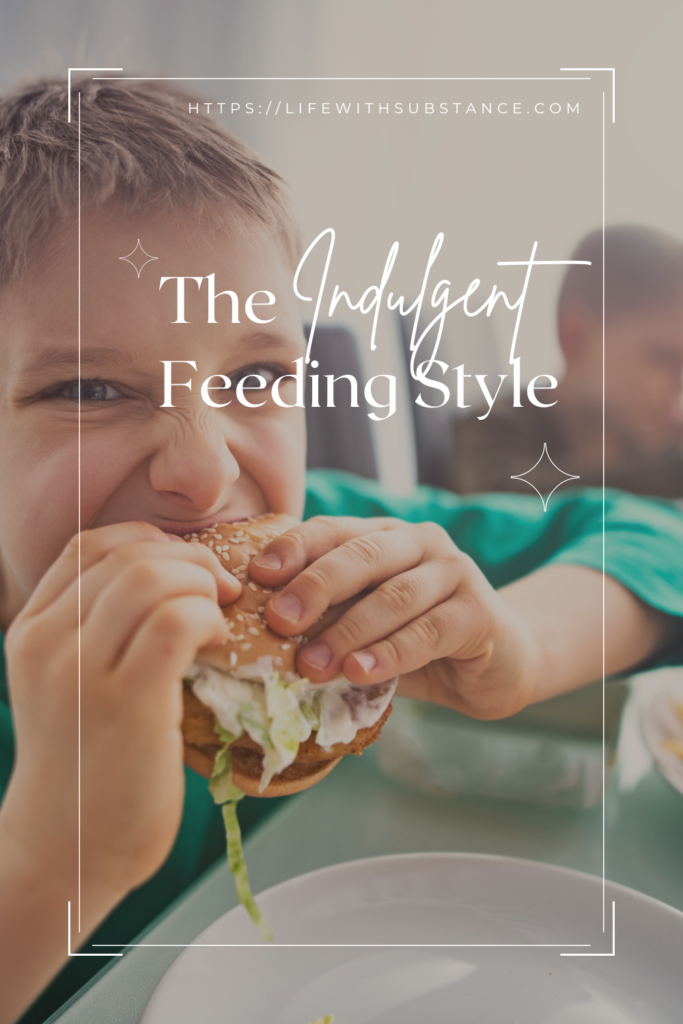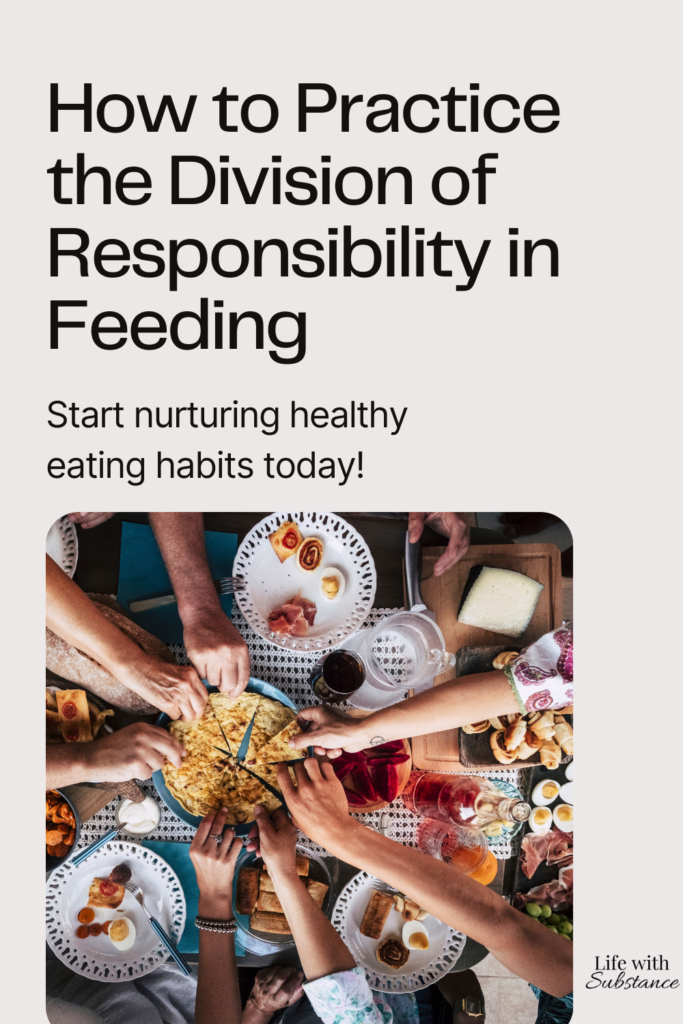This post may contain affiliate links. If you shop from one of our links, we may earn a commission.
We were all raised in different homes, which means we grew up with our own general parenting styles and perceptions of extracurricular activities, school, religious beliefs, and feeding styles. As parents, one of the most important roles we play in our children’s lives is shaping their relationship with food. How we approach feeding our children can have a significant impact on their eating habits, body image, and overall well-being. Understanding the different parental feeding styles can help us navigate this responsibility with confidence and create a positive food environment for our families.
Food Parenting
Unfortunately, not everyone was raised in a home that modeled what a healthy relationship with food looks like and is accepting of body size. Maybe you grew up in a “fend for yourself” type of home and you tend to be lax around mealtime structure and eating as a family. As a child, your parents may have enforced strict food rules, so now you don’t let them eat dessert until their plates are clean.
Food parenting styles describe how you engage with your child around feeding and mealtimes. Various food parenting styles can result in significant differences in whether your child will have a good relationship with food and their body.
There are four different styles of feeding: controlling, indulgent, uninvolved, and diplomatic. Understanding these parent feeding styles and what category you are in helps you better recognize your general attitudes and philosophies around feeding. There are often similarities in the way you parent and your feeding style. While it’s possible to touch on each of these feeding styles, you likely have one that is dominant that you practice consistently.

The Controlling Feeding Style
The controlling feeding style, historically termed the “authoritarian” feeding style, positions the parent firmly at the helm of the eating experience. This style is characterized by a well-intentioned but rigid framework of rules parents use surrounding meal times.
Using food as both a carrot and a stick, phrases like “You can have dessert if you finish your dinner,” demonstrate the conditional nature of this approach. While this method aims to instill discipline and structure around eating, it can inadvertently turn meals into a negotiation rather than a nourishment opportunity.
This style tends to overlook the importance of teaching children to tune into their own bodies’ cues of hunger and satiety. Instead of encouraging a child to listen to their internal signals, the authoritarian parents risk undermining their child’s innate capacity to self-regulate, potentially leading to issues with food regulation later in life. Children raised under this paradigm may also miss out on the joy and exploration of food, as meals become more about compliance than discovery.
Effects of This Style in Feeding
Moreover, the authoritarian style can inadvertently contribute to a poor relationship with food, as children learn to associate eating with external approval or disapproval, rather than intrinsic satisfaction and the child’s needs nutritionally.
Placing restrictions around food can create a heightened desire for those items followed by guilt or shame. Parents who don’t allow sugary items in the house may find their children hiding or sneaking food. The result can be that kids eat these items in excess only to worry they will become overweight from eating “unhealthy food” or “junk food”.
It’s important for us, as parents, to reflect on the implications of this feeding style and consider how we might balance structure with sensitivity to our children’s individual needs and signals. The goal should be to guide rather than govern, creating an environment where children feel supported in understanding their appetites and bodies.

The Indulgent Feeding Style
The permissive or “indulgent” feeding style is more of a relaxed method that models low demands and high responsiveness. The parent has a hard time saying “no” and typically gives in to the child’s wishes. The ‘yes parent’ often prepares food according to their child’s food preferences, which may mean making separate meals to meet their desires.
This approach, marked by its flexibility and responsiveness to a child’s food preferences, can indeed make meal times peaceful and pleasurable. While this feeding style may come off as being loving and considerate can come with its own unique challenges. Especially when it comes to promoting a balanced diet and healthy eating behaviors.
The willingness to prepare separate meals on demand can also inadvertently send a message that it’s okay to avoid new foods. In turn, this can lead to feeding difficulties and encourage picky eating behaviors. Moreover, the lack of structure can make it difficult for children to understand and adhere to regular meal and snack times, and have a difficult time responding to hunger and fullness cues accurately.
There is generally no restriction on what children can eat throughout the day. Without boundaries, kids may show an increased preference for foods high in sugar or fat. Over time, this can lead to weight gain.
It’s important to create structure around meals and snacks while also exposing children to a variety of foods. This doesn’t mean you have to abandon the nurturing aspects of the indulgent style.

The Uninvolved Feeding Style
At the opposite end of the spectrum lies the uninvolved or “neglectful” feeding style, a minimalist approach that takes a hands-off philosophy towards mealtime and nutrition. This style is considered low demand and low responsiveness.
Parents provide the child’s basic nutritional needs but have a lack of interest in nutrition or cooking. While it may seem like a straightforward way to handle feeding, the implications of such an approach can ripple through a child’s relationship with food and their nutritional health.
Parents who follow this method typically do not follow a meal plan, provide structured meals and snacks, and rarely know what to cook for supper. To children, this can appear chaotic and insecure. To compensate for the lack of structure, kids will often seek out food, hide or sneak food, and obsessively think about food.
A child raised in this manner may have trouble trusting their parents. They may also struggle with weight due to overeating when food is available or become underweight as a result of food scarcity. This can be related to food or money availability for the family.

Embracing the Diplomatic Feeding Style
The controlling, indulgent, and uninvolved feeding styles can have a negative impact on your child’s relationship with food. By following a more healthy feeding style, your child in turn, can have a positive association with eating and body image. That’s where the diplomatic feeding style (formerly known as the authoritative style) comes in.
By implementing the authoritative parenting style, a parent nurtures a child’s autonomy while also providing them with the nutrition they need. This method acknowledges the child’s emerging preferences and feelings towards food, while still maintaining the parents’ role in guiding choices that are beneficial for health.
Division of Responsibility
This feeding style is centered around The Division of Responsibility, developed by registered dietitian, Ellyn Satter. The authoritative feeding style helps to equip and empower both parents and kids by establishing roles in feeding.
Parent’s role: Determine what the family will eat, when they will eat, and where.
Child’s role: Determine whether they want to eat what is offered or how much they want to eat.

Studies have shown that children of authoritative parents are better able to honor hunger and fullness cues, feel secure with food, make better choices around food, and maintain a weight that is healthy for them.
Adopting an diplomatic style means recognizing when to offer guidance and when to step back, allowing children to make decisions within a framework that prioritizes health and well-being. It’s about finding a middle ground, where the child feels heard and respected in their likes and dislikes, yet is gently encouraged to explore beyond their comfort zone without pressure.
Additionally, the diplomatic approach reinforces the importance of listening to one’s body, promoting the development of self-regulation skills and the child’s ability to honor their hunger and fullness cues on a regular basis. By instilling these habits early on, children are better equipped to maintain a healthy relationship with food throughout their lives.
What Feeding Style Are You?
Which feeding style do you fall into? What does your child’s relationship with food look like as a result of your feeding style? Do you and your child have positive attitudes around food and mealtimes as a result of your feeding practices?
It’s never too late to make changes when it comes to feeding kids. Start by identifying what feeding style you most often utilize. From there evaluate where you can make small changes over time to implement the diplomatic feeding style.
Need help getting started? Schedule a 1:1 consultation with me today!


